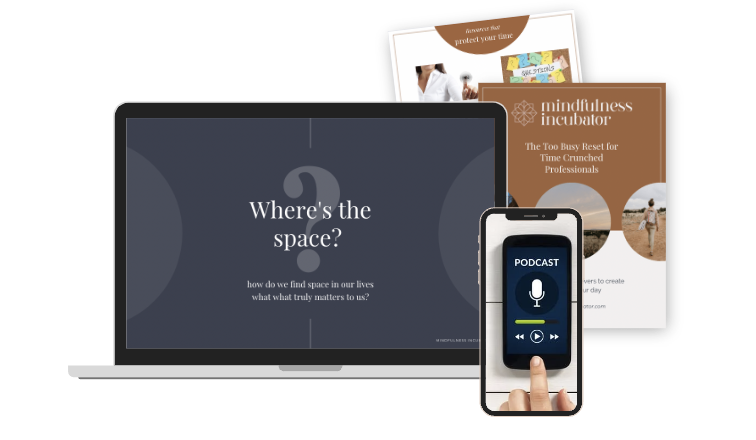Overwhelm 911 - The science of overwhelm & what to do about it
Oct 29, 2022
It’s Friday night. You’ve had a long week. One of those where you barely have time to think. Every day has been back to back meetings. You're desperately trying to keep up with your inbox and your to-dos. Everything is piling up. You’re tired, wound up. Even your body feels tight. You finally find yourself with a free moment. The kids are taken care of. Dinner is in the rearview mirror. You can finally breathe.
Except you can’t. All you can manage to do is binge-watch a mindless TV show, while also distracting yourself with a game on your phone, or scrolling through social media. It’s not relaxing. It’s not self care. And yet you can’t seem to break out of this to do anything else. There are so many things you could be doing that feel like they might be better: a walk, some exercise, social connection, going to bed early. Now you’re dealing with trying to decompress, while also grappling with the guilt that you “should” be doing it a different way. You can’t seem to relax.
Sound familiar?
What’s going on there?
In today’s blog post, we delve into the science of overwhelm, what’s going on when we feel like we need to reset but can’t find the energy to do so, and some simple approaches to cope.
The science of stress and overwhelm
The word “overwhelm” refers to the feeling of being buried, under a pile, and completely overcome. We most often hear it in the context of simply having too much to do without an end in sight.
When we are in overwhelm, physiologically our bodies are experiencing a threat. Our amygdala (a region of our brain that helps process emotions) sends a distress signal, putting the body into survival mode. Stress hormones are pumped out by our adrenal glands. Our heart rate and respiratory rates increase, while “non essential functions'' (like digestion, for example) slow down.
The response to a triggered amygdala is often described as “fight, flight, or freeze”. What does that mean in the modern context?
- Fight behavior might include picking fights, being argumentative or critical.
- Flight behavior might look like adopting avoidant behavior, zoning out, or disengaging.
- Freeze behavior can show up as finding yourself unable to act, clicking through emails without actually seeing anything, seizing up.
The automatic responses of a triggered amygdala might be handy when the threat we’re trying to survive is being chased by a wild animal. Unfortunately, they can also backfire when the “threat” is a never ending assault of emails and action items.
If amygdala triggers and stress responses are new to you, check out this helpful article.
Over time, experiencing sustained overwhelm can lead to multiple health issues and burnout. And unfortunately, it’s not uncommon to spend large swaths of our days in these triggered, high stress states. No wonder we end the day with little left in the tank: our bodies and minds are experiencing the consequences of our overwhelm.
There are, of course, strategies you can implement to help diffuse overwhelm, curb the stress response, and restore a sense of balance, and we’ll get to some of those in just a bit. But what happens when you’ve so deep in it, even doing what you know is the right thing feels impossible?
Overwhelm 911: What you can do when you’re IN the overwhelm
Being stuck in overwhelm can feel like a fuse tripped inside you and everything shut off. You know you should be doing something, but you can’t bring yourself to do it. Let’s talk about how your can care for yourself when that happens.
1. Awareness - The first step is awareness: notice that something is going on for you, that you’re in overwhelm and that you’re struggling to cope. Your “tells” might take different forms. Sometimes it’s a physical reaction - like feeling pressure in your chest, or feeling your tense shoulders creep up to your ears. Other times it’s an overly emotional response, like an extreme reaction to something that shouldn’t be a big deal. Often, it shows up as emotional numbing behaviors, like binge watching television, scrolling social media (or doom scrolling the news), playing mindless games on your phone - or at the most extreme doing multiple of those things at the same time for maximum distraction. Awareness is the first step. Practice noticing and acknowledging when you’re in this space. You might pause, take a deep breath (overwhelm often comes with shallow breathing), and simply say to yourself “I am aware that I am in an overwhelm/stress response, and that is showing up as [numbing through distraction/overreacting/carrying stress in my body]”. As we’ve talked about before, awareness is the precursor to every meaningful change, so noticing is the first step.
2. Self compassion - It’s easy to follow up awareness with self criticism: to give yourself a hard time because you’re failing to live up to your own exacting standard on how you “should” be behaving. Self compassion is when you treat yourself with the kindness, gentleness and understanding that you would extend to someone you love dearly. We first talked about Self Compassion in one of our very favorite blog posts “Mindfulness: Making peace when all your options suck”. Give yourself some grace. You’re having a hard time, and you are doing the best you can. Accept that what you’re doing right now to cope might be all that you can muster, and that’s ok.
3. Self reflection - If you feel up for it, ask yourself what’s going on for you. How did you end up in this state? Were you in an extended state of stress for reasons out of your control? Did you have to deal with higher emotional content (politics, difficult situations, etc.) than what you’re used to? Has your self care been languishing (insufficient sleep, poor diet, etc.)? It’s helpful to understand the conditions that contributed to this feeling. To blamelessly acknowledge what led to your overwhelming overwhelm. If asking yourself these questions in the moment feels like it would make things worse, plan to come back to them when you’re more at ease, and go on to the next step without a whisper of guilt. You’re doing the right thing for you.
4. Self care
Emily & Amerlia Nagowski wrote a brilliant book called “Burnout: The Secret to Unlocking the Stress Cycle” (this article summary is super helpful). One of the core ideas from their research is that we need to find ways to complete the stress cycle and let our bodies know that we’re safe. Without this, our body sustains the unhealthy hormonal cocktail and physiological consequences of a continued stress response. Is there something you can do in this moment to help with your stress response? Can you breathe deeply, go for a short walk, try to change your emotional state? Can you take a bath or a shower, play a game, or do a short meditation? Can you listen to a song you love and dance around a bit? It’s possible that the answer is no, and that those things feel like they are not accessible to you right now. If that’s the case, go to bed (and do a few minutes of deep breathing).
Systematic changes - What you can do about overwhelm when you’re not overwhelmed (right now)
While your interventions might be limited when you’re deep in the throes of overwhelm, there is a lot more you can do to create a system that helps you manage your stress and wellbeing when you’re in a calmer state. There are a few habits and practices that are effective in boosting your resilience to overwhelm, including building more mindfulness and awareness, so that you can notice earlier when you’re at risk of falling off the overwhelm cliff.
We covered some of the basics in our recent Resilience 101 series. Resilience is the ability to bounce back from difficult situations (like sustained stress and overwhelm). Each post from the Resilience 101 series includes a summary of the resilience-enhancing strategy, and some practical ways to get started. If you haven’t checked them out yet, here they are:
- Resilience 101: Journaling as a coping and inspiration tool - the resilience enhancing effects of writing to process difficult emotions, and how to get started with a journaling practice.
- Resilience 101: Meditation as a Resilience Practice - how to start a meditation practice, and the different types of meditation you can try.
- Resilience 101: Goal Setting and Mindset - how having broader goals and a clear vision can help us cope with adversity.
- Resilience 101: The Power of Social Connections - how relationships help us endure when things are tough.
- Resilience 101 - Physical health: food, hydration, sleep and movement - the importance of your physical wellbeing, and practical tips to improve it.
- Resilience 101 - Mindfulness - how being fully aware of what is happening in the here and now helps us withstand difficult situations and fully experience joy.
Want more?
If this is a topic you personally struggle with, consider joining us in our upcoming Boundary Building Blueprint program to create space, build time boundaries, defeat overwhelm and be present for what matters. Over four concise, ridiculously actionable weeks, you will create space for what matters most, and reboot your relationship to your to-do list. The program launches Nov 28th and will have limited space, so make sure you get on the waitlist to be the first to know when registration opens!

Want a nudge to be more mindful? Grab the Mindful in 5 Phone Wallpaper!
Never miss a post!
Get notified anytime we have something new.
We hate SPAM. We will never sell your information, for any reason.



